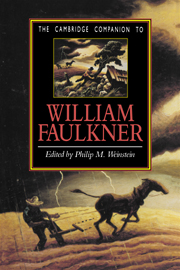6 - Racial Awareness and Arrested Development
The Sound and the Fury and the Great Migration (1915-1928)
from Part II - The World in the Texts
Published online by Cambridge University Press: 28 May 2006
Summary
Nothing in William Faulkner’s large body of writings has received more critical attention than his fourth novel, The Sound and the Fury, which marks the conclusion of the author’s apprenticeship and the beginning of the so-called major period of his literary career. The novel’s stunning technical innovations partially account for this attention, particularly because the difficulty of reading and understanding this text is somehow compatible with being moved by it. Although a solid portion of the critical commentary has been devoted to explications of the experimental form of the novel, the real mystery of the text (and, I think, the reason we return to it again and again) resides in its power to move us. This power is characteristic of the writings Faulkner produced from the end of the 1920s to the early 1940s, that is, from The Sound and The Fury (1929) to Go Down, Moses (1942), writings in which Faulkner grappled with forces of major psychic and social significance.
As the commencement of this trajectory, The Sound and the Fury occupies an ambiguous place, and recent critics have accused it of being too private, too mired in the psychic realm, and too inarticulate about social forces that are more clearly revealed in his later works (cf. Sundquist 1983, Morris). John Matthews, however, has argued that the novel’s cautious articulation of these social forces reflects the "rhetoric of containment" that dominated modernist aesthetics and the New/Jim Crow South (Matthews 1987). Like Matthews, I shall argue here that the novel both flees the material and ideological conditions of its production and seeks to disclose them.
- Type
- Chapter
- Information
- The Cambridge Companion to William Faulkner , pp. 123 - 145Publisher: Cambridge University PressPrint publication year: 1995
- 2
- Cited by



